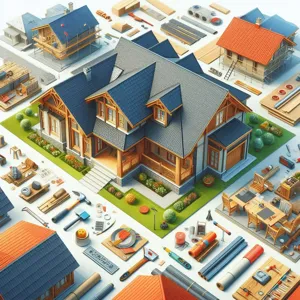When it comes to protecting your home, selecting the right roofing material is crucial, not just for aesthetics but also for durability and functionality.
The roof is your first line of defense against the elements, and it plays a significant role in your home’s overall energy efficiency, safety, and style. With a myriad of options available—from classic asphalt shingles and elegant slate to eco-friendly metal and sturdy wood shakes—navigating the world of roofing materials can feel overwhelming. Each type comes with its own set of advantages, challenges, and visual appeal, making the decision process both exciting and complex. In this comprehensive guide, we’ll delve into the various types of roofing materials, exploring their unique characteristics, benefits, and ideal applications, to help you make an informed choice that not only enhances the beauty of your home but also ensures it stands strong against nature’s challenges. Whether you’re building a new home, renovating, or simply seeking to replace an aging roof, this guide will equip you with the knowledge you need to choose the right shelter for your sanctuary.
1. Introduction to Roofing Materials

When it comes to constructing or renovating a home, one of the most critical decisions you’ll face is selecting the right roofing material. The roof is not just a protective barrier against the elements; it plays a pivotal role in the overall aesthetic, energy efficiency, and longevity of your dwelling. With a myriad of options available, understanding the different types of roofing materials is essential for making an informed choice that aligns with your home’s style, budget, and environmental considerations.
From classic asphalt shingles to sophisticated metal roofing, each material comes with its own unique set of benefits and drawbacks. Asphalt shingles, for instance, are popular for their affordability and ease of installation, making them a go-to for many homeowners. However, if you seek durability and a longer lifespan, materials like slate or tile may be more appropriate, albeit at a higher initial investment.
Moreover, the climate in your area can significantly influence your roofing choice. In regions prone to heavy snowfall or high winds, materials that can withstand these conditions, such as metal or concrete tiles, may be more suitable. On the other hand, if you live in a warmer climate, options like clay tiles or reflective roofing materials that minimize heat absorption can enhance your home’s comfort and reduce cooling costs.
This guide aims to explore the various roofing materials available today, highlighting their features, advantages, and potential drawbacks. By the end, you’ll be equipped with the knowledge needed to select the perfect roofing material that not only complements your home’s architecture but also meets your functional requirements. Let’s dive in and discover the world of roofing materials, ensuring your shelter is not just a house, but a safe haven for years to come.
2. Importance of Choosing the Right Roofing Material
Selecting the right roofing material is one of the most critical decisions you’ll make when constructing or renovating your shelter. It’s not merely about aesthetics; the roofing material you choose significantly impacts your home’s durability, energy efficiency, and overall value.
First and foremost, the right roofing material must align with your climate. For instance, regions prone to heavy snowfall and rain benefit from materials like asphalt shingles or metal, which are designed to shed water effectively and withstand heavy loads. Conversely, in areas with intense sun exposure, materials such as clay tiles or slate can help regulate indoor temperatures, reducing energy costs over time.
Beyond weather resistance, the choice of roofing material influences maintenance requirements and longevity. Some materials, like wood shakes, offer a beautiful, rustic appeal but may require regular treatment and inspection to prevent decay. On the other hand, metal and asphalt shingles generally boast longer lifespans and lower maintenance needs, making them practical choices for homeowners who prefer durability and ease of care.
Additionally, roofing materials contribute to the energy efficiency of your home. Reflective materials can help reduce cooling costs in warmer climates, while proper insulation under the roofing system can keep your home warmer during colder months. This not only enhances comfort but also offers long-term savings on energy bills.
Lastly, don’t underestimate the impact of your roofing choice on your property’s resale value. A well-chosen, high-quality roofing material can enhance curb appeal and attract potential buyers, providing a significant return on your investment. In contrast, a poorly chosen material can lead to costly repairs and diminish your home’s overall value.
In summary, considering the importance of choosing the right roofing material is essential for ensuring your shelter is safe, efficient, and aesthetically pleasing. Take the time to research and consult with professionals to find the best fit for your specific needs and circumstances. Your roof is more than just a cover; it’s the first line of defense against the elements and a key component of your home’s integrity and character.
3. Overview of Common Roofing Materials

When it comes to selecting the right roofing material for your home, understanding the various options available is crucial. Each type of roofing material comes with its own set of advantages, disadvantages, and aesthetic qualities, making the choice a significant part of your overall home design and functionality. Here’s an overview of the most common roofing materials to help you make an informed decision.
**Asphalt Shingles**: One of the most popular choices for homeowners, asphalt shingles are affordable, easy to install, and come in a variety of colors and styles. They typically have a lifespan of 15 to 30 years and are particularly well-suited for a wide range of architectural styles. While they provide decent protection against the elements, they are less durable than some other materials and may require replacement sooner than expected in extreme weather conditions.
**Metal Roofing**: Known for its longevity and durability, metal roofing can last 40 to 70 years with proper maintenance. Available in materials such as aluminum, steel, and copper, it is lightweight, fire-resistant, and energy-efficient, reflecting sunlight to keep homes cooler in warmer climates. While the initial investment may be higher than asphalt shingles, the long-term savings on energy bills and replacement costs can make it a wise choice.
**Clay and Concrete Tiles**: Offering a distinctive look and exceptional durability, clay and concrete tiles are perfect for homeowners seeking a Mediterranean or Spanish-style aesthetic. These materials can withstand harsh weather conditions, including high winds and hail, and can last over 50 years. However, they are heavier than other roofing options, so it’s essential to ensure that your home’s structure can support the weight.
**Slate**: Renowned for its elegance and longevity, slate roofing can last a century or more. Each slate tile is unique, providing a stunning and timeless appearance that can elevate any home’s curb appeal. However, slate is one of the more expensive roofing materials, and its weight requires a reinforced roof structure. Additionally, installation can be more complex, requiring skilled labor.
**Wood Shingles and Shakes**: Wood roofing offers a natural aesthetic that blends beautifully with the environment. Cedar is the most common type used, providing insulation and a charming rustic look. While wood shingles can last 20 to 30 years, they require regular maintenance and treatments to prevent rot, mold, and insect damage. It’s also worth noting that wood roofs may not be suitable in areas prone to wildfires.
**Synthetic Roofing Products**: For those seeking the look of natural materials without the drawbacks, synthetic roofing options have gained popularity. Made from rubber, plastic, or a combination of materials, these products can mimic wood or slate while being lightweight and easier to install. Many synthetic roofs are also designed to be more resistant to weather conditions, offering a lifespan of 30 years or more.
In your quest to choose the right roofing material, consider factors like climate, aesthetic preferences, budget, and the long-term maintenance required. Each option has unique benefits, so take your time to evaluate which material aligns best with your vision for your home. By doing so, you’ll ensure a beautiful and durable roof that stands the test of time.
4. Asphalt Shingles: Pros and Cons
Asphalt shingles are one of the most popular roofing materials in North America, known for their versatility, affordability, and ease of installation. However, like any roofing option, they come with their own set of advantages and disadvantages that homeowners should consider before making a decision.
**Pros of Asphalt Shingles:**
1. **Affordability**: One of the most appealing aspects of asphalt shingles is their cost-effectiveness. They are generally less expensive than other roofing materials, making them a popular choice for budget-conscious homeowners.
2. **Variety of Styles and Colors**: Asphalt shingles come in a wide range of styles, colors, and textures, allowing homeowners to easily match them with the aesthetic of their home. Whether you prefer a traditional look or a more modern appearance, there’s likely an asphalt shingle that fits your vision.
3. **Ease of Installation**: The installation process for asphalt shingles is relatively straightforward and can be completed quickly by experienced roofing professionals. This not only reduces labor costs but also minimizes disruption to your household.
4. **Good Performance**: Asphalt shingles are designed to withstand various weather conditions, including rain, wind, and even mild hail. Many asphalt shingles come with warranties that cover damage from severe weather, providing an additional layer of peace of mind.
**Cons of Asphalt Shingles:**
1. **Lifespan**: While asphalt shingles typically last between 15 to 30 years, this lifespan is shorter compared to other roofing materials like metal or tile, which can last for decades longer. Homeowners may need to budget for a replacement sooner than they would with more durable options.
2. **Susceptibility to Weather Damage**: Although they perform well in many conditions, asphalt shingles can be vulnerable to extreme weather events, particularly high winds and heavy hail. This can lead to premature wear and the need for repairs or replacements.
3. **Environmental Concerns**: Asphalt shingles are made from petroleum-based products, raising concerns about their environmental impact. Additionally, they are not easily recyclable, which can contribute to landfill waste when they reach the end of their lifespan.
4. **Potential for Algae Growth**: In humid climates, asphalt shingles can be prone to algae growth, which can detract from the roof’s appearance and potentially lead to longer-term damage if not addressed. Some manufacturers offer algae-resistant options, but these may come at a higher price.
In summary, asphalt shingles remain a popular choice for many homeowners due to their affordability and variety. However, it’s essential to weigh the pros and cons carefully to determine if they are the right roofing material for your home. By considering factors such as climate, budget, and long-term maintenance, you can make an informed decision that will protect your home for years to come.
5. Metal Roofing: Benefits and Considerations

Metal roofing has surged in popularity in recent years, and for good reason. This durable and versatile option offers a range of benefits that can significantly enhance your home’s protection and aesthetic appeal. Available in a variety of materials, including steel, aluminum, copper, and zinc, metal roofing is renowned for its exceptional longevity, often lasting 40 to 70 years with minimal maintenance. This longevity translates to fewer replacements over time, making it a cost-effective investment in the long run.
One of the standout benefits of metal roofing is its resilience against severe weather conditions. Unlike traditional asphalt shingles, which can succumb to high winds and heavy rain, metal roofs are designed to withstand the elements, including hail, snow, and even wildfires, depending on the coating and material used. Additionally, metal roofs reflect solar radiant heat, which can lead to significant energy savings on cooling costs during the hot summer months.
However, there are considerations to keep in mind when opting for metal roofing. The initial investment can be higher than other materials like asphalt shingles, which may deter some homeowners. Installation typically requires skilled professionals, as improper installation can lead to issues such as leaks or compromised insulation. Furthermore, while metal roofs are low-maintenance, they can be susceptible to dents and scratches, particularly softer metals like aluminum.
Ultimately, choosing metal roofing involves weighing these benefits against the considerations. If you’re looking for a long-lasting, energy-efficient solution that can withstand the test of time and the elements, metal roofing might be the perfect fit for your home. Just be sure to partner with experienced contractors to ensure a seamless installation that maximizes the lifespan and performance of your new roof.
6. Wood Shingles and Shakes: A Natural Choice
When it comes to achieving a rustic aesthetic paired with durability, wood shingles and shakes stand out as a natural choice for roofing materials. These classic options, crafted from cedar, pine, or redwood, evoke warmth and charm, making them a favored choice for both traditional and contemporary homes.
Wood shingles are machine-cut, resulting in a smooth, uniform appearance that lends a polished finish to any structure. In contrast, wood shakes are hand-split, offering a more organic, textured look that highlights the natural grain of the wood. This variation in production methods not only influences their visual appeal but also their performance and longevity.
One of the most appealing aspects of wood roofing is its excellent insulation properties. Wood shingles and shakes provide natural thermal resistance, helping to regulate the temperature inside your home and potentially lowering energy costs. Additionally, they are lightweight and relatively easy to install, making them a practical option for many homeowners.
However, it’s essential to consider the maintenance requirements associated with wood roofing. While they can last for several decades with proper care, they are susceptible to rot, mold, and insect damage if not maintained correctly. Regular inspections, cleaning, and treatment with protective coatings are vital to prolonging their lifespan and ensuring they remain aesthetically pleasing.
Moreover, wood shingles and shakes come with environmental benefits, as they are renewable resources and offer a natural look that blends seamlessly with the surrounding landscape. For those seeking an eco-friendly roofing option, sustainably sourced wood can be a conscientious choice.
In summary, wood shingles and shakes provide a beautiful, natural roofing solution that can enhance your home’s curb appeal while offering practical benefits. If you appreciate the charm of natural materials and are willing to invest in their upkeep, these roofing options could be the perfect fit for your next roofing project.
7. Slate Roofing: Durability and Aesthetics

When it comes to roofing materials that elegantly combine durability and aesthetics, slate roofing stands out as a premier choice for homeowners looking to invest in both performance and beauty. Known for its striking appearance, slate offers a unique charm that can elevate the architectural style of any home, from quaint cottages to grand estates.
Slate tiles are crafted from natural stone, which not only contributes to their stunning visual appeal but also lends unparalleled strength and longevity. This roofing material is renowned for its resistance to extreme weather conditions, including heavy rain, snow, and high winds. With a lifespan that can exceed a century when properly installed and maintained, slate roofing is often seen as a long-term investment that adds significant value to a property.
In terms of aesthetics, slate is available in a variety of colors, including rich grays, deep blacks, and vibrant greens and purples. This natural variation allows homeowners to select a roofing style that complements their home’s exterior and surrounding landscape. Additionally, slate’s natural texture creates a sophisticated, timeless look that can enhance curb appeal and attract potential buyers should you decide to sell your home in the future.
However, it’s important to note that the installation of slate roofing requires a skilled professional, as the tiles are heavy and need to be installed with precision to ensure proper drainage and longevity. While the initial investment may be higher compared to other roofing materials, the durability and unmatched beauty of slate roofing make it a worthwhile consideration for those seeking a reliable and aesthetically pleasing option. In summary, if you desire a roof that marries timeless elegance with robust performance, slate roofing could be the perfect match for your home.
8. Tile Roofing: Styles and Longevity
Tile roofing is a timeless choice that combines aesthetic appeal with impressive longevity, making it an attractive option for homeowners looking to enhance their property’s curb appeal while ensuring long-term durability. Available in various materials, including ceramic, concrete, and slate, tile roofs come in an array of styles, colors, and textures, allowing homeowners to select a design that complements their architectural vision.
**Styles of Tile Roofing**
The beauty of tile roofing lies in its versatility. From the classic Mediterranean look characterized by terracotta tiles to the sleek, modern lines of flat concrete tiles, the options are virtually limitless. For a more rustic aesthetic, homeowners might opt for Spanish-style tiles, which feature a distinctive S-shaped curve. Alternatively, slate tiles offer a sophisticated and elegant touch, perfect for traditional or upscale homes. The rich colors and natural variations in slate also ensure that each roof has a unique character, enhancing its overall charm.
Moreover, tile roofing can be customized to suit various climates. In hotter regions, lighter-colored tiles can reflect sunlight, helping to keep homes cooler, while heavier tiles are ideal for areas that experience heavy snowfall, as they can withstand the weight without succumbing to damage.
**Longevity of Tile Roofing**
One of the standout features of tile roofing is its extraordinary longevity. When properly installed and maintained, tile roofs can last anywhere from 50 to over 100 years, making them one of the most durable roofing options available. This impressive lifespan not only provides peace of mind for homeowners but also results in long-term savings on repairs and replacements.
Additionally, tile roofs are inherently resistant to rot, insects, and fire, further enhancing their durability. While they may require a higher initial investment compared to other roofing materials, the return on investment is significant, both in terms of property value and the reduced need for maintenance or replacement over time.
In essence, tile roofing offers a perfect blend of style and longevity, making it an excellent choice for those looking to invest in a roof that will stand the test of time while adding character to their home. Whether you prefer the rustic charm of Spanish tiles or the sleek modernity of concrete, there’s a tile roofing option that will meet your needs and elevate your home’s aesthetic.
9. Synthetic Roofing Materials: Innovation and Sustainability
In an era where sustainability and innovation go hand in hand, synthetic roofing materials are emerging as a popular choice for homeowners and builders alike. These materials, often crafted from a blend of recycled plastics, rubber, and other composites, are designed to mimic the aesthetics of traditional roofing while offering enhanced durability and environmental benefits.
One of the most notable advantages of synthetic roofing is its lightweight nature, which reduces the overall load on the structure and can simplify installation. Unlike traditional materials, synthetic options are often engineered to withstand harsh weather conditions, including heavy winds, hail, and extreme temperatures. This resilience translates to a longer lifespan, making them a cost-effective choice in the long run.
Additionally, synthetic roofing materials come in a vast array of styles, colors, and textures, allowing homeowners to achieve the desired look for their home without sacrificing performance. Whether you’re aiming for the classic appearance of slate or the rustic charm of wood shakes, there’s a synthetic option that can meet your aesthetic needs.
Sustainability is at the forefront of synthetic roofing innovation. Many manufacturers prioritize eco-friendly practices, using recycled materials in their products and promoting energy efficiency. Some synthetic roofs are designed to reflect sunlight, effectively reducing heat absorption and lowering energy costs for cooling. This not only benefits the environment but also contributes to a more comfortable living space.
Moreover, the installation of synthetic roofing can often be completed more swiftly than traditional materials, minimizing labor costs and disruption to your daily life. As the construction industry continues to evolve, synthetic roofing materials represent a forward-thinking choice that aligns with modern values of sustainability, innovation, and aesthetic appeal.
In summary, if you’re considering roofing options that combine longevity, style, and eco-friendliness, synthetic materials may just be the perfect solution for your home. Embracing these innovative products not only enhances your property’s curb appeal but also supports a more sustainable future.
10. Factors to Consider When Choosing Roofing Materials
Choosing the right roofing materials is a crucial decision that can significantly impact the longevity, aesthetics, and functionality of your shelter. When considering your options, there are several key factors to keep in mind that will guide you to the best choice for your specific needs.
**1. Climate:** The climate in your area plays a pivotal role in determining the most suitable roofing materials. For instance, if you live in a region prone to heavy snowfall, materials such as metal or slate, which can withstand the weight and prevent moisture buildup, may be ideal. Conversely, in warmer climates with intense sunlight, materials like clay tiles or reflective roofing can help keep your home cooler and protect against UV damage.
**2. Durability and Lifespan:** Different roofing materials offer varying levels of durability and lifespan. Asphalt shingles, while cost-effective, typically last around 15-30 years. In contrast, materials like metal or slate can last upwards of 50 years or more. Evaluating how long you plan to stay in your home and your willingness to invest in a long-lasting solution will guide your decision.
**3. Aesthetic Appeal:** The appearance of your roof can greatly influence your home’s curb appeal. Consider the architectural style of your home and choose roofing materials that complement it. For example, wooden shingles provide a rustic charm, while sleek metal panels can give a modern edge. Color, texture, and design are all important elements that contribute to the overall aesthetic.
**4. Cost and Budget:** Budget is often a deciding factor when selecting roofing materials. While some materials may have a lower upfront cost, it’s essential to consider long-term expenses, including maintenance, repair, and potential energy savings. Always weigh the initial investment against the long-term benefits and durability to ensure you make a financially sound choice.
**5. Environmental Impact:** As sustainability becomes increasingly important, many homeowners are considering the environmental impact of their roofing materials. Options such as recycled metal, slate, or sustainably sourced wood can help minimize your ecological footprint. Additionally, energy-efficient roofing materials can contribute to lower energy consumption, making them a responsible choice for the environment.
**6. Local Building Codes:** Before making a final decision, check with your local building codes and regulations. Certain areas may have specific requirements or restrictions regarding roofing materials, especially in regions prone to wildfires or extreme weather. Compliance with these codes is crucial to ensure your roof is not only safe but also legal.
By taking these factors into account, you can make an informed decision when selecting roofing materials that not only protect your home but also enhance its beauty and value. Whether you prioritize durability, aesthetics, or sustainability, choosing the right roofing can lead to a shelter that stands the test of time.
11. Climate and Weather Impacts on Roofing Decisions
When it comes to choosing the right roofing material, understanding the climate and weather patterns of your region is paramount. Your roof is not just a protective barrier; it’s a vital component that must withstand the elements while enhancing the overall aesthetic and energy efficiency of your home.
In areas prone to heavy rainfall, such as the Pacific Northwest, materials like asphalt shingles or metal roofing can be advantageous due to their excellent waterproofing capabilities. Metal roofs, in particular, are known for their durability and resistance to corrosion, making them ideal for regions with high humidity and frequent storms.
Conversely, if you live in a region with extreme temperatures, such as the Southwest, you’ll want to consider roofing materials that can handle both scorching sun and occasional hail. Tile roofs, for example, are popular in sunny areas because they reflect sunlight and can keep homes cooler. Additionally, they are highly durable and can withstand extreme weather conditions, including heavy winds and hail.
For those in snowy climates, your choice of roofing material should account for the weight of snow accumulation. Slate and wooden shingles are excellent options due to their strength and ability to shed snow effectively. Proper roof pitch is also crucial in these areas to prevent ice dams and ensure that snow slides off rather than accumulating.
Lastly, don’t overlook the importance of local regulations and insurance requirements, which can influence your roofing choices. Some communities may have specific guidelines regarding materials and colors, especially in historical or ecologically sensitive areas.
By carefully considering the climate and weather impacts on your roofing decisions, you can choose a material that not only protects your home but also contributes to its longevity and aesthetic appeal. Making an informed choice will ultimately save you time and money on repairs and replacements down the line, ensuring your roof stands strong against whatever Mother Nature throws your way.
12. Cost vs. Longevity: Budgeting for Your Roof
When it comes to roofing materials, the age-old debate of cost versus longevity plays a crucial role in the decision-making process. Investing in a roof is not just about the initial price tag; it’s an important consideration that will affect your finances for years to come. Understanding the balance between upfront costs and long-term durability can help you make an informed choice that fits your budget and protects your home.
For instance, asphalt shingles are often the go-to option for homeowners seeking a budget-friendly roofing solution. They are relatively inexpensive to install, but their lifespan typically ranges from 15 to 30 years, depending on the quality of the shingles and local climate conditions. While asphalt may save you money initially, you might find yourself facing replacement costs sooner than you’d like, especially in harsh weather areas.
On the other hand, materials like metal roofing and slate offer an impressive longevity—ranging from 40 to 100 years—yet they come with a significantly higher price point. Metal roofs are known for their durability and energy efficiency, while slate provides an unmatched aesthetic appeal and resistance to the elements. Although the initial investment is substantial, the long-term savings on maintenance and replacement can justify the expense.
When budgeting for your roof, it’s also important to consider factors such as warranties, maintenance costs, and potential increases in property value. A high-quality roof can enhance your home’s curb appeal and serve as a selling point should you choose to move in the future.
In essence, while it may be tempting to opt for the lowest price, weighing the benefits of longevity and durability against your budget will ultimately lead you to a roofing solution that not only meets your immediate financial needs but also provides lasting protection for your home. Take the time to assess your options carefully, and don’t hesitate to consult with roofing professionals who can provide insights tailored to your specific situation. By understanding the relationship between cost and longevity, you can secure a roof that stands the test of time, ensuring peace of mind for years to come.
13. Maintenance Requirements for Different Roofing Types
When selecting the right roofing material for your home, it’s essential to consider not only aesthetics and cost but also the maintenance requirements associated with each type. Different roofing materials come with varying levels of upkeep, which can significantly impact your long-term satisfaction and investment.
**Asphalt Shingles**: One of the most popular roofing choices, asphalt shingles are known for their affordability and ease of installation. Maintenance is relatively simple—regular inspections, cleaning out gutters, and replacing damaged or missing shingles can help extend their lifespan. However, homeowners should be aware that they may need to be replaced every 15 to 30 years, depending on the climate and quality.
**Metal Roofing**: Renowned for its durability and longevity, metal roofing can last 40 to 70 years with minimal maintenance. However, it’s crucial to inspect it regularly for rust and ensure that the seams remain watertight. Cleaning debris and checking for loose fasteners will go a long way in maintaining its integrity.
**Tile Roofing**: Often associated with Mediterranean or Spanish-style homes, tile roofs are both beautiful and robust. While they can last over 100 years, they do require more maintenance than some other materials. Regular inspections for cracked or broken tiles are necessary, and a professional cleaning every few years can help prevent algae and moss buildup.
**Wood Shakes and Shingles**: While offering a natural and rustic aesthetic, wood roofing requires considerable maintenance. Homeowners must regularly treat the wood to prevent rot, mold, and insect infestation. Cleaning and inspecting for missing or damaged shakes is essential to prolong the lifespan, which typically ranges from 20 to 40 years.
**Slate Roofing**: Slate is one of the most durable roofing materials available, boasting a lifespan of over 100 years. However, its weight requires a sturdy structure for support, and maintenance can be costly. Regular inspections for cracked or missing slates are important, and any repairs should be performed by a professional to maintain the roof’s integrity.
**green Roofs**: An increasingly popular eco-friendly option, green roofs involve planting vegetation on top of a waterproof membrane. While they provide excellent insulation and biodiversity benefits, they require significant maintenance, including regular watering, weeding, and monitoring of the drainage system to ensure the vegetation remains healthy.
In conclusion, understanding the maintenance requirements for each roofing type is crucial in making an informed decision. By evaluating your own willingness to perform routine upkeep, the climate in your area, and how long you plan to stay in your home, you can choose a roofing material that not only enhances your property’s curb appeal but also fits seamlessly into your lifestyle.
14. Environmental Impact of Roofing Materials
When it comes to selecting roofing materials, it’s essential to consider not just aesthetics and durability, but also the environmental impact of your choices. The roofing industry has made significant strides in developing eco-friendly options that minimize harm to the planet while enhancing the energy efficiency of homes and buildings.
One of the most environmentally conscious choices is metal roofing. Made from recyclable materials, metal roofs are known for their longevity and ability to reflect solar heat, thereby reducing energy costs. Additionally, many manufacturers have adopted sustainable practices in their production processes, further lowering their carbon footprint.
Another green option is clay or concrete tiles. These materials are derived from natural resources and are incredibly durable, often lasting over 50 years. Their thermal mass helps regulate indoor temperatures, reducing the need for excessive heating and cooling. Furthermore, clay tiles can be recycled at the end of their life cycle, making them a sustainable choice.
Asphalt shingles, while popular for their affordability, can pose environmental challenges due to their petroleum-based composition. However, some companies are now offering shingles made from recycled materials, which can mitigate their impact. If you choose asphalt, look for products labeled as “cool roofs,” which are designed to reflect more sunlight and absorb less heat, contributing to energy savings.
Finally, consider green roofing systems, which incorporate vegetation into the roofing design. These living roofs not only provide insulation and reduce stormwater runoff but also promote biodiversity and improve air quality. They require a more substantial investment and maintenance but offer significant ecological benefits.
In summary, evaluating the environmental impact of roofing materials is crucial for making an informed choice. By selecting eco-friendly options, you not only enhance the sustainability of your home but also contribute to a healthier planet. Whether you prioritize recyclability, energy efficiency, or innovative green solutions, there are plenty of choices available that align with your environmental values.
15. Conclusion: Making an Informed Choice for Your Roof
In conclusion, selecting the right roofing material is a decision that extends far beyond mere aesthetics; it encompasses durability, energy efficiency, maintenance, and overall cost-effectiveness. As you navigate through the myriad of options available—from traditional asphalt shingles and elegant slate to innovative metal and eco-friendly green roofs—it’s essential to consider your specific needs and circumstances.
Take the time to assess your local climate, architectural style, and personal preferences. Each roofing material has its unique benefits and drawbacks, and understanding these nuances will empower you to make an informed choice that suits both your lifestyle and your budget.
Don’t hesitate to consult with roofing professionals who can provide insights tailored to your unique situation. They can help you weigh factors such as lifespan, warranty options, and installation costs, ensuring you choose a roof that not only enhances your home’s curb appeal but also stands the test of time.
Ultimately, the roof over your head is one of your home’s most vital defenses against the elements. By investing the time and effort into selecting the right material, you’ll ensure that your home remains safe, comfortable, and beautiful for years to come. Remember, a well-chosen roof is not just a protective layer; it’s a long-term investment in your home’s value and your peace of mind.
In conclusion, selecting the right roofing material is a crucial step in ensuring the longevity, safety, and aesthetic appeal of your home. By understanding the various types of roofing materials available, from traditional asphalt shingles to eco-friendly metal and tile options, you can make an informed decision that aligns with your budget, climate, and personal style. Remember to consider factors such as durability, maintenance requirements, and energy efficiency as you weigh your options. With careful consideration and the insights provided in this guide, you can confidently choose a roofing solution that not only protects your home but also enhances its overall character. Thank you for joining us on this journey toward finding the perfect shelter for your abode—may your roof keep you safe and stylish for many years to come!






